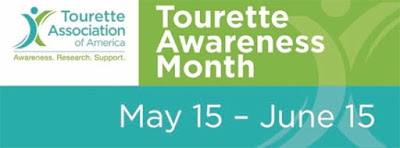Tourette's Syndrome
What is Tourette's Syndrome?
"...Gilles de la Tourette syndrome (Tourette Syndrome or TS)
is a neurological disorder which becomes evident in early childhood or
adolescence. The first symptoms usually are involuntary movements (tics) of the
face, arms, limbs or trunk. These tics are frequent, repetitive and
rapid. The most common first symptom is a facial tic (eye blink, nose
twitch, grimace), and is replaced or added to by other tics of the neck, trunk,
and limbs. .."
Where does Tourette Syndrome fall under IDEA?
Tourette syndrome is classified as an other health impairment.
IDEA Description of Other Health Impairment:
"...(9) Other health impairment means having limited
strength, vitality, or alertness, including a heightened alertness to
environmental stimuli, that results in limited alertness with respect to the
educational environment, that--
(i) Is due to chronic or acute health problems such as
asthma, attention deficit disorder or attention deficit hyperactivity disorder,
diabetes, epilepsy, a heart condition, hemophilia, lead poisoning, leukemia,
nephritis, rheumatic fever, sickle cell anemia, and Tourette syndrome; and
(ii) Adversely affects a child's educational
performance...."Indicators of TS
According to Kids Health, the main indicators of Tourette's Syndrome are tics.What are Tics?
Tics are sudden, repetitive movements or sounds that can be difficult to control. There are two types of tics: motor tics and vocal tics. Motor tics involve movement whereas vocal tics involve sounds.Tics can also be classified as either simple or complex. Simple motor tics involve a single muscle group whereas complex motor tics involve more than one muscle group and are not as rapid as simple motor tics. Complex vocal tics involve more meaningful words or speech than simple motor tics.
Other indicators of Tourette syndrome include:
- Multiple bouts of tics every day or intermittently for more than a year
- Changes in the frequency, number, and kind of tics and in their severity
- Marked distress or significant impairment in social, occupational, or other areas of functioning, especially under stressful condition
- Onset before age 18
Source: Children's Mental Health Service
Video: Living with Tourette Syndrome
In this video, children with Tourette Syndrome talk about what tics are, different kinds of tics, trying to suppress tics, and bullying because of tics.
What Other Conditions are Associated with Tourette Syndrome?
Tourette syndrome is often accompanied by other conditions or syndromes. The two most common comorbid conditions are Attention Deficit Hyperactivity Disorder (ADHD) and Obsessive Compulsive Disorder (OCD). Other conditions include rage-attacks, depression, and sleeping disorders.Source: Mol Debes, N. M. (2013). Co-morbid disorders in Tourette syndrome. Behavioural Neurology, 27(1), 7-14.
Video: Carlos Guevara's Struggle Won't Hold Him Back
The video showcases a high school freshman who lives with Tourette Syndrome but found a way to follow his dream.
Accommodations/ Modifications
Writing Problems:
- Copy down or complete every other problem
- Allow child to present a taped report instead of a written one
- Assign a note-taking buddy
- Allow extra time for tests
- Allow student to use spell checker
Language Problems
- Provide visual and auditory input whenever possible
- Provide written and oral instructions
- Have a copy of lecture outline to help the student follow along
- Ask student to repeat instructions and check in to ensure they have been done properly
- Give child a note card with a cut out "window" to display only one word while reading
- allow student to communicate information orally
Attention Problems
- Seat child in front of teacher for instruction and directions to minimize distractions
- Seat child away from windows, doors, etc.
- Have an area of the room where the student can go to help them focus
- Allow for some work to be done in advance when appropriate




No comments:
Post a Comment